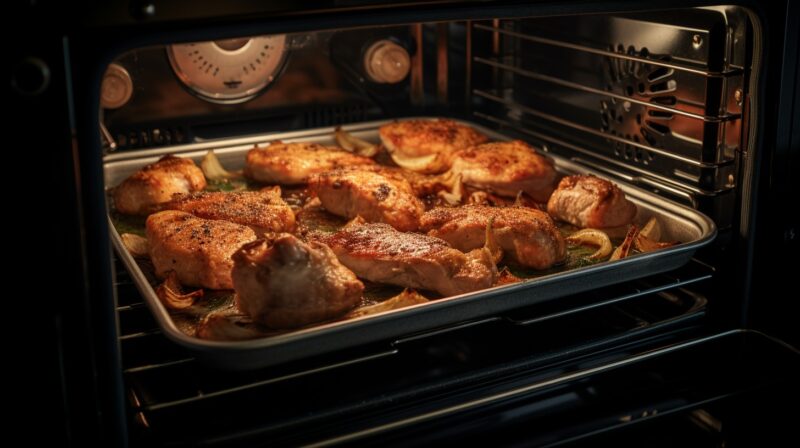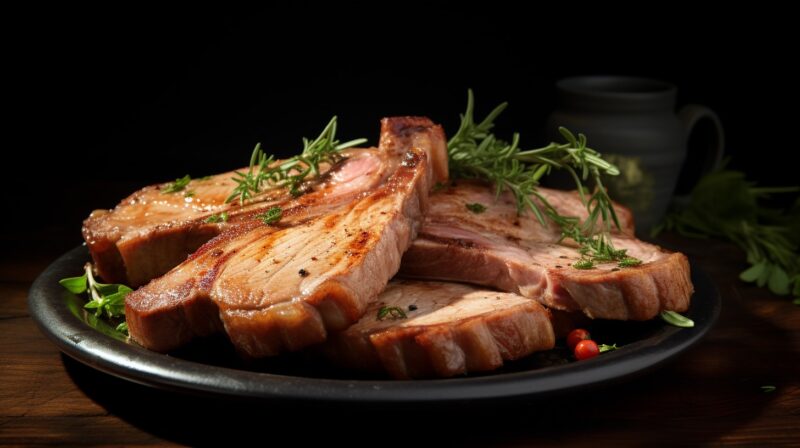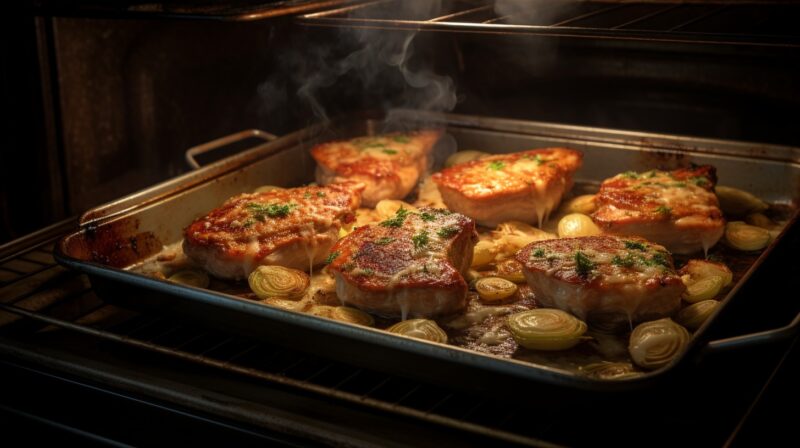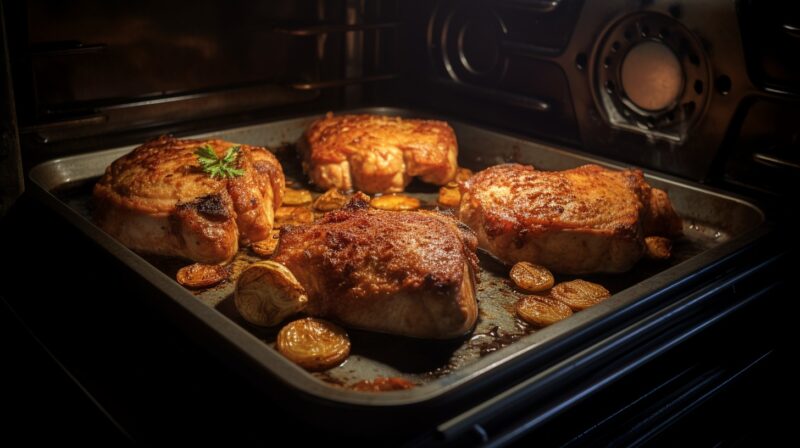Baking bone-in pork chops is a simple and effective method to achieve juicy, flavorful meat. The key to perfect results lies in the cooking time and temperature, which depend on the thickness of the chops. Oven temperatures typically range between 350°F to 375°F, ensuring the pork cooks thoroughly without drying out.
But, the question is – How long to bake it? I will share my insights and a delicious recipes in the following sections.
Key Takeaways
- Cooking the Bone-In Pork Chops usually require between 20 and 30 minutes.
- The general recommended baking temperature for pork chops is around 350°F to 375°F
What is the Recommended Baking Time?
Baking bone-in pork chops to perfection hinges on understanding the balance between oven temperature, chop thickness, and cooking time. The goal is to achieve a juicy, flavorful outcome without overcooking. Here’s a breakdown of how to nail the process every time.
Oven Temperature and Chop Thickness

The oven should be preheated to a sweet spot between 350°F and 375°F. This range is optimal for cooking the meat thoroughly while preserving its moisture.
- For 1-inch thick bone-in pork chops, aim for a baking time of 20 to 25 minutes at 375°F.
- For chops that are 1.5 inches thick, adjust the cooking time to 25 to 30 minutes.
It’s important to note that these guidelines serve as a starting point. The ultimate indicator of doneness is the internal temperature of the pork.
Internal Temperature – The Gold Standard
Achieving an internal temperature of 145°F ensures the pork is cooked safely and remains moist. After reaching this temperature, let the chops rest for 3 minutes. This rest period allows juices to redistribute, making every bite succulent. A meat thermometer is indispensable for accurately gauging this temperature. Ensure it’s inserted into the thickest part of the chop without touching the bone for an accurate reading.
What Can Affect the Cooking Time?
Cooking times can vary due to several factors:
- Starting Temperature: Chops at room temperature cook more evenly than those straight from the refrigerator.
- Oven Calibration: Not all ovens heat the same; some run hotter or cooler than their set temperature.
- Bone-In vs. Boneless: Bone-in chops typically take a bit longer to cook than boneless due to the insulating effect of the bone.
- Brining: Brined pork chops can cook faster due to the moisture content added during the brining process.
Additional Tips
- Do Not Overcrowd: Ensure pork chops are spaced out on the baking sheet or dish. Overcrowding can lead to steaming instead of baking, affecting texture and flavor.
- Flip Halfway Through: Turning the chops halfway through the baking time promotes even cooking and browning.
- Rest Before Serving: Allowing the chops to rest after baking is crucial. This step ensures juices redistribute throughout the meat, enhancing flavor and tenderness.
Undercooked and Overcooked – Issues and How to Avoid

Cooking pork chops to the right doneness is a balancing act. Undercooking or overcooking can ruin a meal, leading to safety concerns or a disappointing eating experience. Here’s how to navigate these issues and ensure your pork chops turn out perfectly.
Undercooked Pork Chops
Issues: Undercooked pork can be unsafe. It may harbor harmful bacteria like Trichinella spiralis, leading to foodborne illnesses. Texturally, undercooked pork is tough and chewy, making it unappetizing.
How to Avoid?
- Use a Meat Thermometer: The most reliable way to ensure pork is cooked safely is to use a meat thermometer. Aim for an internal temperature of 145°F, followed by a 3-minute rest.
- Let Pork Sit at Room Temperature: Before cooking, let the pork chops sit out for about 15 to 30 minutes. Room temperature meat cooks more evenly, reducing the risk of undercooking.
Overcooked Pork Chops
Issues: Overcooking dries out pork chops, making them tough and flavorless. The loss of moisture results in a less enjoyable eating experience.
How to Avoid?
- Monitor Cooking Time and Temperature: Keep a close eye on the oven temperature and cooking time. Adjustments may be necessary based on the thickness of the chops and individual oven characteristics.
- Rest the Meat: Allowing pork chops to rest after cooking helps retain moisture. Even if slightly overdone, resting can improve texture by redistributing juices within the meat.
- Check Temperature Early: Start checking the internal temperature a few minutes before the minimum recommended cooking time. This prevents accidentally surpassing the ideal temperature.
General Tips for Perfect Pork Chops
- Preheat the Oven: Ensure the oven reaches the desired temperature before baking. An accurately preheated oven promotes even cooking.
- Avoid Frequent Opening: Opening the oven door too often can lead to temperature fluctuations, affecting cooking time and evenness.
- Understand Your Oven: Recognize if your oven runs hot or cold and adjust cooking times and temperatures accordingly.
Bonus Recipe – Learn to Prepare Perfect Bone-in Pork Chops

Achieving perfectly baked bone-in pork chops requires attention to detail and a straightforward approach.
Ingredients
- 4 bone-in pork chops, approximately 1 to 1.5 inches thick
- Salt and freshly ground black pepper, to taste
- 2 tablespoons olive oil
- 2 cloves garlic, minced
- 1 teaspoon rosemary or thyme (fresh or dried, based on preference)
- Optional: 1 tablespoon butter for finishing
Instructions
- Preheat the Oven: Start by heating your oven to 375°F. A properly preheated oven ensures even cooking.
- Season the Pork Chops: While the oven heats, season both sides of the pork chops generously with salt and pepper. This basic seasoning is crucial for flavor.
- Prepare the Pan: Heat olive oil in a large oven-proof skillet over medium-high heat. Add the minced garlic and herbs to the oil, stirring for about 1 minute until fragrant. This infuses the oil, adding depth to the chops’ flavor.
- Sear the Pork Chops: Add the pork chops to the skillet. Sear each side for 2-3 minutes until they develop a golden-brown crust. Searing locks in flavors and improves texture.
- Bake: Transfer the skillet to the preheated oven. Bake the pork chops for about 20-25 minutes for 1-inch thick chops, or 25-30 minutes for 1.5-inch thick chops. The goal is an internal temperature of 145°F, so start checking a few minutes before the expected time.
- Rest the Meat: After reaching the desired internal temperature, remove the pork chops from the oven. Optionally, place a small piece of butter on each chop for added richness. Let them rest for 3 minutes. Resting allows juices to redistribute, ensuring each bite is moist and flavorful.
- Serve: Serve the pork chops immediately after resting. They pair well with a variety of sides, from roasted vegetables to mashed potatoes.
Additional Tips
- Always use a meat thermometer to check doneness. It’s the most reliable method to ensure your pork chops are perfectly cooked.
- Adjust cooking times based on the actual thickness of your pork chops and the specific characteristics of your oven.
- The optional butter added at the end melts over the warm pork chops, adding a luxurious finish to the dish.
FAQs
Should I cover pork chops with foil when baking?
Covering pork chops with foil can help them retain moisture and prevent them from drying out. However, if you want a crispy crust, you should uncover them for the last few minutes of baking.
Should you flip pork chops in the oven?
Flipping pork chops in the oven is not necessary, as they will cook evenly on both sides. However, some people prefer to flip them halfway through for extra browning and flavor.
Is it quicker to fry or bake pork chops?
Frying pork chops is usually quicker than baking them, as they only need a few minutes per side on a hot skillet. Baking pork chops can take 15 to 25 minutes, depending on their thickness and oven temperature.
Should you oil pork chops before seasoning?
Oiling pork chops before seasoning can help the seasonings stick better and create a nice sear. However, you should use a high-heat oil, such as canola, corn, safflower, or grapeseed oil, and avoid using too much oil, as it can cause splattering and smoking.
Summary
Perfecting bone-in pork chops is straightforward: season well, control the oven temperature, and nail the timing. Begin with a generous seasoning of salt and pepper, sear to achieve a golden crust, and bake until the internal temperature hits the sweet spot of 145°F. Avoiding undercooked or overcooked pork chops is crucial for both safety and taste. By focusing on these essential steps, you ensure each pork chop is juicy, flavorful, and thoroughly enjoyable.
We have other tips that will help you improve your cooking skills. For example, you can learn How to Thaw a Brisket Before Smoking.
